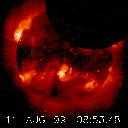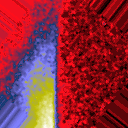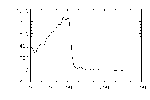Eclipse results - a quasi real time success
Science Nugget: August 13, 1999
1. Introduction
As the  limited
readership of these notes knows quite well, a satellite in an orbit like
Yohkoh's
gets many opportunities to observe partial eclipses of the Sun. In our
case, of course, it is partial eclipses of the X-ray corona. From the point
of view of spacecraft control, an eclipse is a tricky business because
the Sun sensors don't work as advertised. Accordingly we have made many,
many mistakes in the past, even though we have made some rather spectacular
observations. This time we were brave enough to promise movies of
the August 11, 1999 eclipse to an extremely prominent Japanese TV program.
To succeed, we would have to get the movies made within a few minutes after
reception of the data. So... this Science Nugget is to boast that we succeeded!
The material provided for TV use may be found on the
"quasi-real-time"
eclipse pages, which include large movies (which may be slow to download)
in .gif format. A still from this page appears on the right:
limited
readership of these notes knows quite well, a satellite in an orbit like
Yohkoh's
gets many opportunities to observe partial eclipses of the Sun. In our
case, of course, it is partial eclipses of the X-ray corona. From the point
of view of spacecraft control, an eclipse is a tricky business because
the Sun sensors don't work as advertised. Accordingly we have made many,
many mistakes in the past, even though we have made some rather spectacular
observations. This time we were brave enough to promise movies of
the August 11, 1999 eclipse to an extremely prominent Japanese TV program.
To succeed, we would have to get the movies made within a few minutes after
reception of the data. So... this Science Nugget is to boast that we succeeded!
The material provided for TV use may be found on the
"quasi-real-time"
eclipse pages, which include large movies (which may be slow to download)
in .gif format. A still from this page appears on the right:
2. So what good is it to observe an eclipse?
This is a frequently asked question. The SXT chief observer often answers
"because it's fun," but in fact there are potentially important applications
of these data. The Moon is opaque even to our powerful X-rays, and the
Moon's edge is almost smooth on the angular scales of our pixels. Thus
it is a rather good mask or knife-edge; it is good for probing the level
of scattered light, the solar astronomer's chief bugaboo. H. Hara has already
used the latter property to estimate the scattered-light level in a coronal
hole on the solar disk, a crucial measurement, from an earlier eclipse
observation. We now comment below briefly on the knife-edge property of
the images.
3. A lunar knife edge
 The
image on the right shows how SXT viewed the eclipse of an active region
on the NE limb. This image looks odd -- it has three separate parts --
because of the way the SXT on-board software works: an image 192x192 pixels,
as this one, requires three separate exposures, one for each EW strip.
The Moon's image is in three different places at the times of the
three different exposures, so the three parts of the image don't fit together
very well.
The
image on the right shows how SXT viewed the eclipse of an active region
on the NE limb. This image looks odd -- it has three separate parts --
because of the way the SXT on-board software works: an image 192x192 pixels,
as this one, requires three separate exposures, one for each EW strip.
The Moon's image is in three different places at the times of the
three different exposures, so the three parts of the image don't fit together
very well.
 To
carry out a simple analysis using this exposure as a knife edge, we've
taken the left middle part of the above image, and rotated it by 42 degrees
to make the Moon's limb vertical. This makes it easy, using simple
IDL software, to make a plot of how well the telescope images the sharp
drop of brightness that occurs at the edge of the moon's image.
To reduce the effect of counting statistics, we've summed the bottom 10
rows of pixels in this image, since we don't expect significant variation
in the vertical dimension.
To
carry out a simple analysis using this exposure as a knife edge, we've
taken the left middle part of the above image, and rotated it by 42 degrees
to make the Moon's limb vertical. This makes it easy, using simple
IDL software, to make a plot of how well the telescope images the sharp
drop of brightness that occurs at the edge of the moon's image.
To reduce the effect of counting statistics, we've summed the bottom 10
rows of pixels in this image, since we don't expect significant variation
in the vertical dimension.

The plot on the right, which we've made in this manner, is pretty self-explanatory.
This shows how the brightness varies along this horizontal strip of 10
combined rows of pixels in the plot to the left. It shows a precipitous
drop in the brightness at the limb of the Moon; the part to the left is
the solar active region, but the part to the right is in the shadow of
the moon. Here we see a bit of scattered light. The distance between the
3/4 and 1/4 intensity levels, a crude measure of the width of the core
of the point response function, is 3.6" (about 1.5 pixels), confirming
that the 2.4" SXT pixels are too big to sample the point response function
of the instrument properly (we really need 2 pixels to critically sample
the image). We knew this already! But more detailed analysis
of this data, plus others in the archive, could really teach us a lot about
how the SXT optics work. Unfortunately we did not get enough exposures
that were long enough, so this eclipse will be limited by counting statistics
for applications like this. At this position the Moon's limb was moving
rapidly, so a longer exposure might have caused appreciable blurring.
Now that Chandra, NASA's huge grazing-incidence X-ray telescope for
astrophysics, has been launched, we'll expect to see some really, really
good grazing-incidence images of distant bits of the Universe, but in the
meanwhile SXT is making nice images of bits of the Universe at almost exactly
one A.U. distance, and we need to understand these too.
H. Hudson (hudson@isass1.solar.isas.ac.jp)
August 13, 1999
 To
carry out a simple analysis using this exposure as a knife edge, we've
taken the left middle part of the above image, and rotated it by 42 degrees
to make the Moon's limb vertical. This makes it easy, using simple
IDL software, to make a plot of how well the telescope images the sharp
drop of brightness that occurs at the edge of the moon's image.
To reduce the effect of counting statistics, we've summed the bottom 10
rows of pixels in this image, since we don't expect significant variation
in the vertical dimension.
To
carry out a simple analysis using this exposure as a knife edge, we've
taken the left middle part of the above image, and rotated it by 42 degrees
to make the Moon's limb vertical. This makes it easy, using simple
IDL software, to make a plot of how well the telescope images the sharp
drop of brightness that occurs at the edge of the moon's image.
To reduce the effect of counting statistics, we've summed the bottom 10
rows of pixels in this image, since we don't expect significant variation
in the vertical dimension.

 limited
readership of these notes knows quite well, a satellite in an orbit like
Yohkoh's
gets many opportunities to observe partial eclipses of the Sun. In our
case, of course, it is partial eclipses of the X-ray corona. From the point
of view of spacecraft control, an eclipse is a tricky business because
the Sun sensors don't work as advertised. Accordingly we have made many,
many mistakes in the past, even though we have made some rather spectacular
observations. This time we were brave enough to promise movies of
the August 11, 1999 eclipse to an extremely prominent Japanese TV program.
To succeed, we would have to get the movies made within a few minutes after
reception of the data. So... this Science Nugget is to boast that we succeeded!
The material provided for TV use may be found on the
"quasi-real-time"
eclipse pages, which include large movies (which may be slow to download)
in .gif format. A still from this page appears on the right:
limited
readership of these notes knows quite well, a satellite in an orbit like
Yohkoh's
gets many opportunities to observe partial eclipses of the Sun. In our
case, of course, it is partial eclipses of the X-ray corona. From the point
of view of spacecraft control, an eclipse is a tricky business because
the Sun sensors don't work as advertised. Accordingly we have made many,
many mistakes in the past, even though we have made some rather spectacular
observations. This time we were brave enough to promise movies of
the August 11, 1999 eclipse to an extremely prominent Japanese TV program.
To succeed, we would have to get the movies made within a few minutes after
reception of the data. So... this Science Nugget is to boast that we succeeded!
The material provided for TV use may be found on the
"quasi-real-time"
eclipse pages, which include large movies (which may be slow to download)
in .gif format. A still from this page appears on the right:
 The
image on the right shows how SXT viewed the eclipse of an active region
on the NE limb. This image looks odd -- it has three separate parts --
because of the way the SXT on-board software works: an image 192x192 pixels,
as this one, requires three separate exposures, one for each EW strip.
The Moon's image is in three different places at the times of the
three different exposures, so the three parts of the image don't fit together
very well.
The
image on the right shows how SXT viewed the eclipse of an active region
on the NE limb. This image looks odd -- it has three separate parts --
because of the way the SXT on-board software works: an image 192x192 pixels,
as this one, requires three separate exposures, one for each EW strip.
The Moon's image is in three different places at the times of the
three different exposures, so the three parts of the image don't fit together
very well.